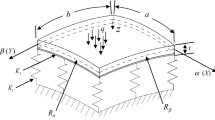The boundary-discontinuous double Fourier series-based solution methodology is used to solve the problem of higher-order shear deformation of cross-ply plates and doubly curved panels, which are characterized by a system of five highly coupled linear partial differential equations with mixed-type simply supported boundary conditions prescribed at all four their edges. The present solution is related to a number of unsolved boundary-value problems and can serve as a tool in particular for early design stages and for benchmark comparisons and verifications of numerical results. The analytical results obtained are compared with finite-element calculations, and a good agreement is found to exist between them.







Similar content being viewed by others
References
E. W. Hobson, The Theory of Functions of a Real Variable, Vol. II, 2nd Edition, Harren Press (1950).
S. Goldstein, The Stability of Viscous Fluid Flow Under Pressure Between Parallel Planes, in: Proceedings of Cambridge Philosophical Society 32, (1936), 40-55.
S. Goldstein, The Stability of Viscous Fluid Flow Between Rotating Cylinders, in: Proc. of Cambridge Philosophical Soc., 33, 41-55 (1937).
A. S. Oktem, The Effect of Boundary Conditions on the Response of Laminated Thick Composite Plates and Shells, Ph.D. Dissertation, University of Utah, Salt Lake City, USA (2005).
R. A. Chaudhuri, “On boundary-discontinuous double Fourier series solution to a system of completely coupled P.D.E.’s.,” Int. J. Eng. Sci., 27(9), 1005-1022 (1989).
R. A. Chaudhuri, “On the roles of complementary and admissible boundary constraints in Fourier solutions to boundary-value problems of completely coupled rth order P.D.E.’s.,” J. Sound Vibrat., 251, 261–313 (2002).
R. A. Chaudhuri and H. R. H. Kabir, “A boundary-continuous-displacement based Fourier analysis of laminated doublycurved panels using classical shallow shell theories,” Int. J. Eng. Sci., 30, 1647-1664 (1992).
R. A. Chaudhuri and H. R. H. Kabir, “Static and dynamic analysis of finite general cross-ply doubly-curved panels using classical shallow shell theories,” Compos. Struct., 28, 73-91 (1994).
A. S. Oktem and R. A. Chaudhuri, “Levy type Fourier analysis of thick cross-ply doubly-curved panels,” Compos. Struct., 80, 475-488 (2007).
Oktem, A. S. and R. A. Chaudhuri, “Fourier analysis of thick cross-ply Levy type clamped doubly-curved panels,” Compos. Struct., 80, 489-503 (2007).
A. S. Oktem and R. A. Chaudhuri, “Higher-order theory based boundary-discontinuous Fourier analysis of simply supported thick cross-ply doubly curved panels,” Compos. Struct., 89, 448-458 (2009).
A. S. Oktem and C. Guedes Soares, “Boundary discontinuous Fourier solution for plates and doubly curved panels using a higher order theory,” Compos. Part B: Eng., 42(4), 842-850 (2011).
J. N. Reddy and C. F. Liu, “A higher-order shear deformation theory of laminated elastic shells,” Int. J. Eng. Sci., 23, 319-330 (1985).
Acknowledgment
The first author was financed by the Portuguese Foundation of Science and Technology under the contract number SFRH/BPD/47687/2008.
Author information
Authors and Affiliations
Corresponding author
Additional information
Russian translation published in Mekhanika Kompozitnykh Materialov, Vol. 48, No. 1, pp. 95-110, January-February, 2012.
Rights and permissions
About this article
Cite this article
Oktem, A.S., Soares, C.G. Analysis of the static response of cross-ply simply supported plates and shells based on a higher-order theory. Mech Compos Mater 48, 65–76 (2012). https://doi.org/10.1007/s11029-012-9252-z
Received:
Published:
Issue Date:
DOI: https://doi.org/10.1007/s11029-012-9252-z




